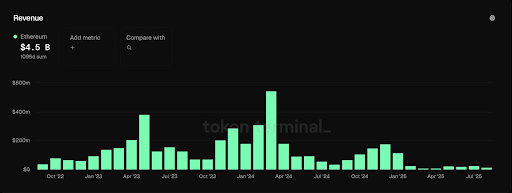Ethereum fee burn revenue fell 44% in August to $14.1M, signaling a clear reduction in network demand; this decline contrasts sharply with January 2024’s $550M peak and suggests lower transaction congestion despite ETH trading above $4,300.
-
Ethereum’s fee burn revenue dropped 44% in August to $14.1M.
-
January 2024 recorded a record $550M in fee burns; early 2025 revenues approached near-zero levels.
-
Lower fee burns indicate reduced network activity and potential implications for ETH scarcity and supply dynamics.
Ethereum fee burn revenue fell 44% to $14.1M in August—read why this matters for ETH holders and network demand.
What happened to Ethereum fee burn revenue in August?
Ethereum fee burn revenue fell 44% in August to $14.1 million, driven by lower transaction demand and reduced network congestion. This decline comes while ETH price holds above $4,300, highlighting a divergence between market valuation and on-chain activity.
How did monthly fee burn trends evolve from 2022 to 2025?
Fee burn cycles showed sharp peaks and troughs between October 2022 and mid-2025. Total burn revenue over the measured 1,095 days reached roughly $4.5 billion. Revenue rose from sub-$100M monthly in late 2022 to highs of $150–$200M in early 2023, spiking to $550M in January 2024 before compressing toward near-zero in early 2025.
Ethereum fee burn revenue fell 44% in August to $14.1M, highlighting weaker network demand despite ETH’s price holding above $4,300.
- Ethereum’s fee burn revenue dropped 44% in August to $14.1M, showing network demand cooling even as ETH trades above $4,300.
- ETH once hit a record $550M in fee burns back in January 2024, but by early 2025 revenues slid dangerously close to zero.
- The sharp revenue drop hints at slower network use, raising concerns about momentum while ETH’s price still looks steady.
Ethereum’s network revenue from fee burns has sharply fallen, signaling weaker demand despite ETH trading near record highs. Plain text source: Satoshi Club reports fee burns at $14.1 million in August, down 44% from July’s $25.6 million.
Why does a fee burn decline matter for ETH holders and supply?
Fee burns directly reduce circulating ETH when transaction fees are destroyed under the EIP-1559 mechanism. Lower fee burn revenue reduces the offset to issuance, which can lessen long-term scarcity pressure. Even with price resilience, declining burns may weaken the narrative that ETH is being steadily removed from supply.
How do price and burn trends compare in recent months?
ETH remains price-resilient—trading around $4,314.65 with a 24-hour volume above $24 billion, per CoinMarketCap (plain text). Yet on-chain metrics show reduced fee revenue, implying fewer high-fee transactions and lower network congestion despite active trading markets.

When did revenue peak and what followed?
Revenue peaked in January 2024 at $550M, driven by intense network demand. After that peak, the market moved through alternating months of growth and weakness. By early 2025, the trend turned sharply downward with several months showing near-zero fee burns as user activity and high-fee transactions declined.
Frequently Asked Questions
What is the main driver of Ethereum fee burns?
Fee burns are driven by transaction demand and gas prices under EIP-1559; more transactions and higher gas usage produce larger burns, directly reducing circulating ETH.
Will low fee burns affect ETH price?
Low fee burns reduce supply-side deflationary pressure, which can weaken long-term bullish arguments; however, price is also influenced by macro factors, staking flows, and institutional demand.
Key Takeaways
- Major decline: August fee burns fell 44% to $14.1M, indicating cooling demand.
- Peak contrast: January 2024 saw a $550M record month; current levels are substantially lower.
- Actionable insight: Monitor transaction volume, gas prices, and burn trends to assess whether network demand will recover.
Conclusion
Ethereum’s fee burn revenue decline to $14.1M in August highlights weakening on-chain demand despite ETH’s price stability above $4,300. Ethereum fee burn revenue trends remain a key indicator of network health and token scarcity. Observers should watch incoming on-chain metrics for signs of renewed activity or continued cooling.
